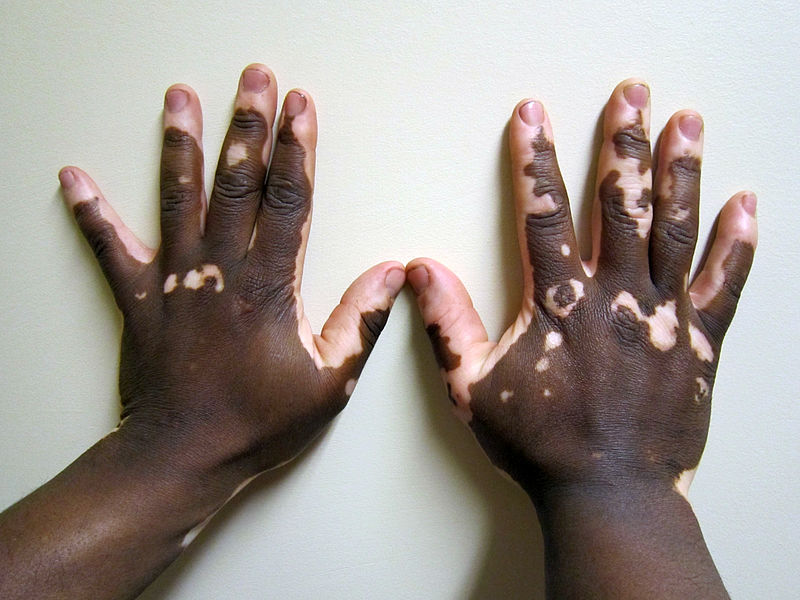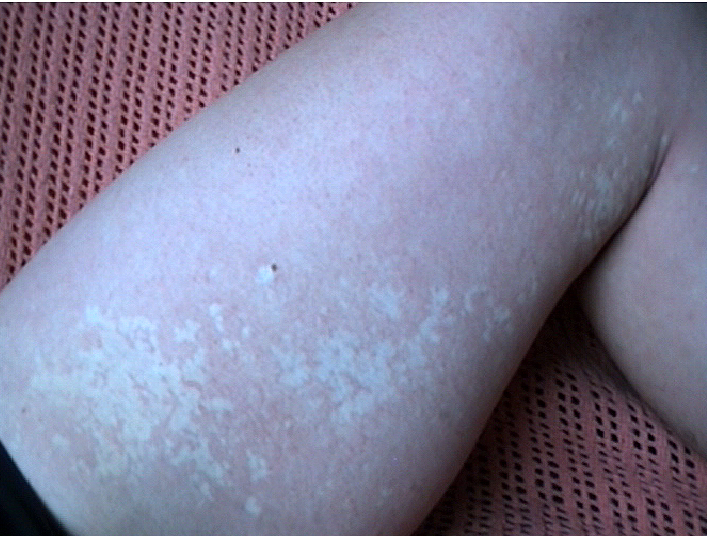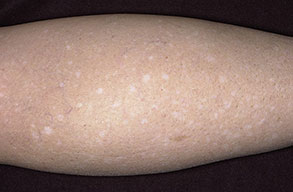


White spots on skin can be an extremely distressing occurrence, one that may affect your quality of life and self-confidence. They are typically caused by a skin pigmentation, or skin color, disorder. Skin cells producing melanin create your specific pigmentation. When your cells become damaged, normal melanin production is interrupted. This can lead to irregular skin pigmentation, which can be in the form of white spots and may even affect your entire body. There are a few conditions that can cause these skin pigmentation problems. We will explore these by discussing associated symptoms and treatment options.

Vitiligo is characterized by the loss of brown skin pigmentation that causes white spots to appear on your body. This condition occurs when the cells destroy the melanocytes - the cells that produce brown pigment. It is estimated that 1 out of every 100 people in the United States are inflected with vitiligo.
The sole symptom of this skin disorder is the manifestation of white spots throughout the body. These spots will be irregular in size and shape, and feel like normal skin. These white patches most commonly affect the face, elbows, knees, hands, feet, and genitalia region.
If you have white, irregular patches on your skin, then you may have vitiligo. It is recommended that you seek medical attention promptly for diagnosis and treatment. The doctor will be able to diagnose you with vitiligo after conducting a skin examination.
Treatment of vitiligo can be quite difficult, so it is important to seek treatment once symptoms surface. Phototherapy is one treatment option, involving the application of ultraviolet light to the skin by a professional dermatologist. This treatment normally coincides with medication to be applied to the skin, such as corticosteroid creams, immunosuppressant creams, and other topical drugs.
If vitiligo is ignored, it can become quite severe and will require different treatment. Skin grafting may be an option, involving normal skin grafted onto the white spots. However, if the white spots ultimately encompass nearly your entire body, then the best option may be to de-pigment the remaining brown skin. This is an extremely radical change that can be quite hard for a person to deal with.

This is another condition that causes white spots on skin due to abnormalities in your melanocytes. Unlike vitiligo, this condition causes static and non-progressive white spots on skin. The chief symptom of this skin disorder is the appearance of white patches on a specific region of your body. In 19% of cases, these white spots are apparent at birth, but may also occur at any later stage during a person's life. Some describe the appearance of these white spots as 'splashes of paint'. Moreover, any hair growth in these areas will be colorless or white.
Currently, there is no known cure for nevus depigmentosus. People normally cover it with makeup if it is in a visible location.

This is a pigmentation disorder that causes white spots to appear on the shins and forearms of an individual. These white spots lack pigmentation and have a marked reduction in melanocytes. Genetics likely play a role in this disorder, as a person is more likely to develop Idiopathic guttate hypomelanosis if a family member also has it.
A person who is faired skin is more at risk of developing Idiopathic guttate hypomelanosis, but darker skinned individuals may also develop it. The symptoms of this disorder are white spots that most commonly infect the skin of the shin and forearm, but it has also been observed to infect the face, neck, and shoulders. They are normally 2 to 5-mm in diameter, not raised, and smooth or scaly in texture (depending on the individual).
Treatment for this skin disorder is not normally sought after due to the small size of the resulting spots. However, if you have cosmetic concerns, there are several options for improving the appearance of your skin. The most common method is applying makeup to cover the white spots. Additional options include light cryotherapy, topical steroids, pinch grafts, and localized superficial dermabrasion.
A halo mole - This is when a mole is surrounded by a white patch or 'halo'. This common condition is characterized as an autoimmune response, in which the body decides to destroy a specific mole. It can also be caused by skin damage. There is no treatment for this disorder, though it will typically rectify itself. However, the inflicted person will need to apply sun cream to the area before going out in the sun, as the halo mole is very susceptible to sun damage.
Pityriasis alba - This skin condition commonly affects children and teenagers. At the onset of the skin disorder, red-pinkish blotches will appear on the child or teenager. This color will eventually dissipate and will be replaced by white patches. These white patches will be dry and scaly in texture, and may also be itchy.
Hopefully this article has helped you to decipher the cause of any white spots on your skin. If you are still unsure, consult a physician for a professional diagnosis.